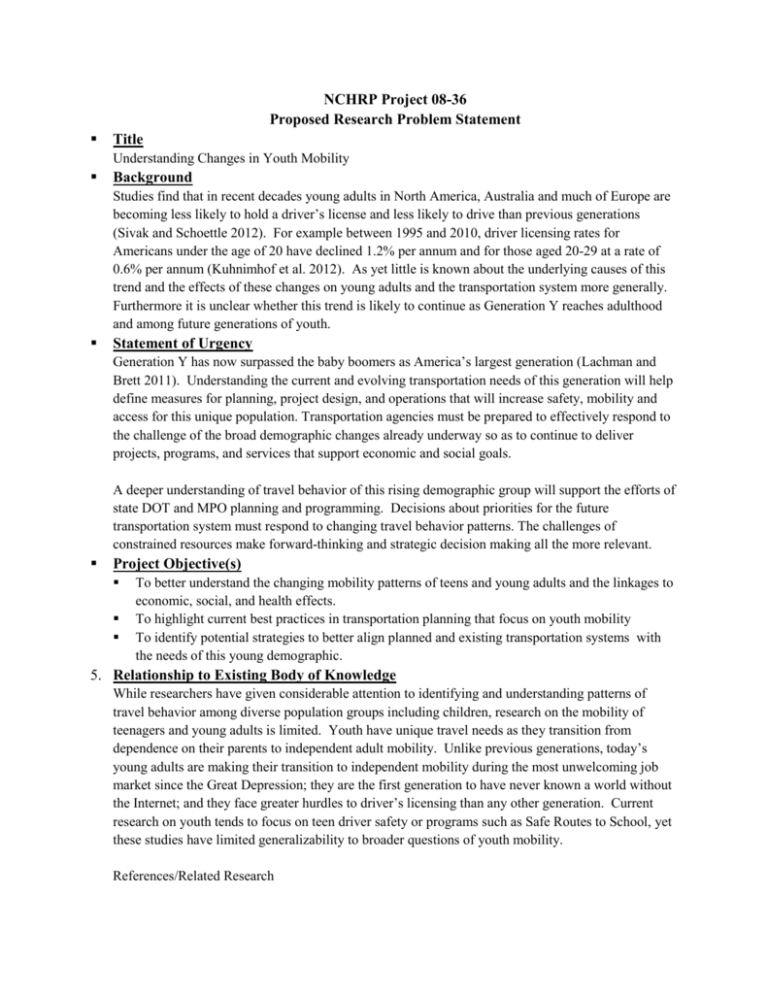YouthMobility
advertisement

NCHRP Project 08-36 Proposed Research Problem Statement Title Understanding Changes in Youth Mobility Background Studies find that in recent decades young adults in North America, Australia and much of Europe are becoming less likely to hold a driver’s license and less likely to drive than previous generations (Sivak and Schoettle 2012). For example between 1995 and 2010, driver licensing rates for Americans under the age of 20 have declined 1.2% per annum and for those aged 20-29 at a rate of 0.6% per annum (Kuhnimhof et al. 2012). As yet little is known about the underlying causes of this trend and the effects of these changes on young adults and the transportation system more generally. Furthermore it is unclear whether this trend is likely to continue as Generation Y reaches adulthood and among future generations of youth. Statement of Urgency Generation Y has now surpassed the baby boomers as America’s largest generation (Lachman and Brett 2011). Understanding the current and evolving transportation needs of this generation will help define measures for planning, project design, and operations that will increase safety, mobility and access for this unique population. Transportation agencies must be prepared to effectively respond to the challenge of the broad demographic changes already underway so as to continue to deliver projects, programs, and services that support economic and social goals. A deeper understanding of travel behavior of this rising demographic group will support the efforts of state DOT and MPO planning and programming. Decisions about priorities for the future transportation system must respond to changing travel behavior patterns. The challenges of constrained resources make forward-thinking and strategic decision making all the more relevant. Project Objective(s) To better understand the changing mobility patterns of teens and young adults and the linkages to economic, social, and health effects. To highlight current best practices in transportation planning that focus on youth mobility To identify potential strategies to better align planned and existing transportation systems with the needs of this young demographic. 5. Relationship to Existing Body of Knowledge While researchers have given considerable attention to identifying and understanding patterns of travel behavior among diverse population groups including children, research on the mobility of teenagers and young adults is limited. Youth have unique travel needs as they transition from dependence on their parents to independent adult mobility. Unlike previous generations, today’s young adults are making their transition to independent mobility during the most unwelcoming job market since the Great Depression; they are the first generation to have never known a world without the Internet; and they face greater hurdles to driver’s licensing than any other generation. Current research on youth tends to focus on teen driver safety or programs such as Safe Routes to School, yet these studies have limited generalizability to broader questions of youth mobility. References/Related Research Kuhnimhof, T., Armoogum, J., Buehler, R., Dargay, J., Denstadli, J. M. and Yamamoto, T. (2012). "Men Shape a Downward Trend in Car Use among Young Adults—Evidence from Six Industrialized Countries." Transport Reviews 32(6): 761-779. Kuhnimhof, T., Zumkeller, D. and Chlond, B. (2013). Who are the ‘drivers’ of peak car? A decomposition of recent car travel trends for six industrialized countries Transportation Research Board 92nd Annual Meeting. Washington, DC. Lachman, M. L. and Brett, D. L. (2011). Generation Y: America's new housing wave. Washington, DC, Urban Land Institute. Sivak, M. and Schoettle, B. (2012). "Update: percentage of young persons with a driver’s license continues to drop." Traffic Injury Prevention 13: 341. 6. List of Anticipated Work Tasks Provide an up-to-date review of current research on youth mobility with an emphasis on studies that can inform current practice in planning and project development. Assess current policies and practices in the transportation industry that affect youth, including o The effect of graduated driver’s licensing regulations on travel behaviour, o The role of social networks on travel behaviour and how technology may complement or substitute trip-making behaviour, and o The use of flexible or hybrid modes such as car sharing, taxi, or jitney services. o How existing data collection efforts (NHTS, regional travel surveys, etc) can be improved to better understand the travel needs and preferences of this unique population. Define the key issue areas for youth mobility in transportation planning, project design, and maintenance and operations. Identify methods of outreach to engage youth in planning and project development processes, as well as delivering system information (transit schedule info, safety). Accomplishing this task will require approaches that actively connect with youth; activities could include small pilots, focus groups, and workshops as well as analyses of travel data. Develop well-defined priorities for a research agenda focused on youth mobility. 7. Estimate of Funds Needed $60,000 8. Estimate of Time Needed to Complete the Research 10 months 9. Name, Affiliation and Contact Information of Submitter(s) Ann M Hartell, MRP Wirtschafts Universitat Wien/Vienna University of Economics and Business Elisabethstrasse 15/7 A-1010 Wien Austria ahartell@gmail.com Submitted on behalf of the TRB Committee on Social and Economic Factors in Transportation. 10. Date of Submittal August 16, 2013


